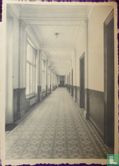



Catalogue information
addressed to Krijtstraat 16 Antwerp Postmarked July 16, 1946 Stamps Belgian 5 centimes Orange N ° 419 small state coat of arms, issue 1935 Stamp 60 centimes small Sttats coat of arms N ° 527 issue 1941 History. In 1829 the sisters Melanie, Rosalie, Virginie and Henriette Van Biervliet from Izegem started the boarding school "Sainte-Marie", a primary girls' boarding school located in a corner building of the Karnemelkstraat and the Hoogstraat, on the former training ground of the Sint-Jorisgilde (cf. Hoogstraat). In 1838 they move into the newly built "Sinte-Maria School" on the corner of Krommewalstraat and Kerkstraat, where from 1849, in addition to primary and secondary education, the first West Flemish free primary school for girls was created. After three sisters (Rosalie, Melanie and Henriette) took their monastic vows in 1856, the "Congregation of the Holy Family" was founded, after which the school was renamed "Institute of the Dames Van Biervliet", later replaced by the name of the congregation . In the course of the 19th century, additional branches were opened in Brussels and Leuven. In 1891 the mother house is moved from Tielt to Schaarbeek; the congregation is called from then until today the "Holy Family of Helmet". In 1884 a paying primary boys 'school and a free primary girls' school were opened; l.g. is a training school and is initially located on the corner of Keidam and Krommewalstraat, later transferred to Bruggestraat. In 1886 Superior Justine De Monie added a free secondary school to the institute, the first in the country. Three years later, the primary girls' school is given a housekeeping class as an upper secondary school. In 1913-1914 (laying of the foundation stone on 21 July 1913) on the south side of the Hulstplein, on the site "De Witte Kave" where Achiel De Volder operated a farm with an oil and brickworks shop until 1881, an imposing eclectic school and monastery complex was built with neo-gothic chapel on the south side and detached school building on the north-east side. The architect is unknown. Even before the official opening of the school, the complex served during the First World War as a "Ludwig Barracks", including a bathing establishment or "Badeanstalt" and a civil prison. Only in 1919-1920 the school, popularly known as "De Damen", can move into the new complex. The old school buildings on the Krommewalstraat form the cradle of the Sint-Andries hospital (1924) (cf. Krommewalstraat nrs. 7-11). In 1928 the old humanities and the higher normal school for agricultural economics (already discontinued in 1934) are founded. A model farm was also connected to the school, located along the Driesstraat. In 1938 the land register registers a small extension to the west wing. During the Second World War, the school complex was transformed into a military hospital; two red crosses are painted on the roof to protect it from bombing. In 1951 there is an extension with a modern humanities and the following year with a pre-school normal school. The existing buildings will be expanded at the front and rear; a new wing connects the front building with the school buildings at the Adolf Loosveldstraat - Driesstraat intersection, where several outbuildings are being demolished. In the late 1950s - early 1960s, the institute acquires the old factory buildings of the "s.a. Tissage Ter Hulst" on the east side of Beernegemstraat, the linen and cotton weaving mill that industrialist Joseph Waelkens founded in 1903 (cf. Beernegemstraat no. 4). The buildings will be converted into classrooms with a covered playground. From 1960 to 1982 a novitiate was established in part of the complex along the Beernegemstraat. A new detached building is erected on the north side in 1966. In 1999 the sisters leave the school complex and form the community "Zonhove" with location near the school building, where previously the already split-off community "Mikaël" is located, which then moves to the former house of the spiritual director. At present, the Heilige Familie-Instituut has merged with the Sint-Jozefscollege to form the comprehensive school "De Bron" with only secondary education; primary school retains the name "Holy Family". In the years 1990-2000, some major renovation works were carried out by the Vandommele architectural firm (Izegem): demolition of the old factory buildings with classrooms along Beernegemstraat and construction of a new school building (1997), adaptation works to the facade (1998), renovation of the wing (2000 ), demolition of the neo-Gothic chapel is said to be due to poor physical condition (2001-2002), construction of a multipurpose hall and sanitary block (2003) and general renovation and refurbishment works (2005-2006). Tielt is a town and city in the Belgian province of West Flanders. It lies in the triangle of Ghent, Bruges and Kortrijk. The city has almost 20,000 inhabitants and is the capital of the district of the same name of Tielt.
This text has been translated automatically from Dutch
Click here for the original text



